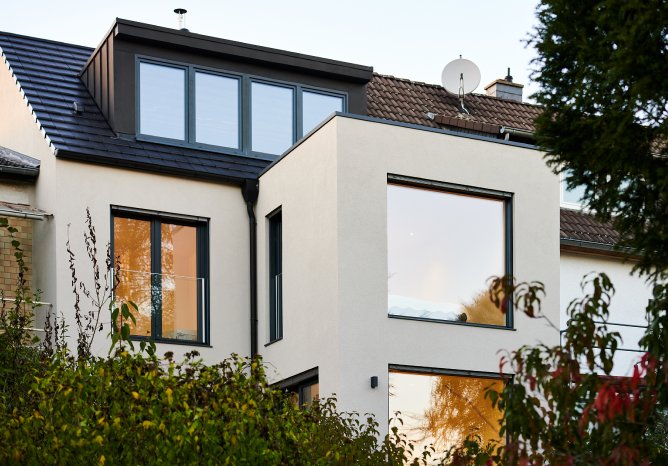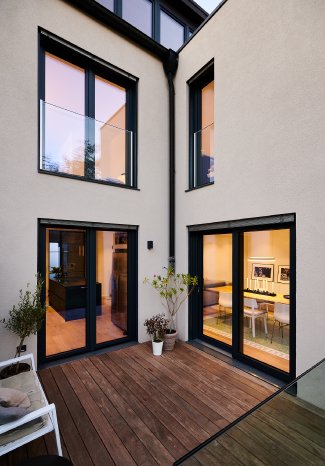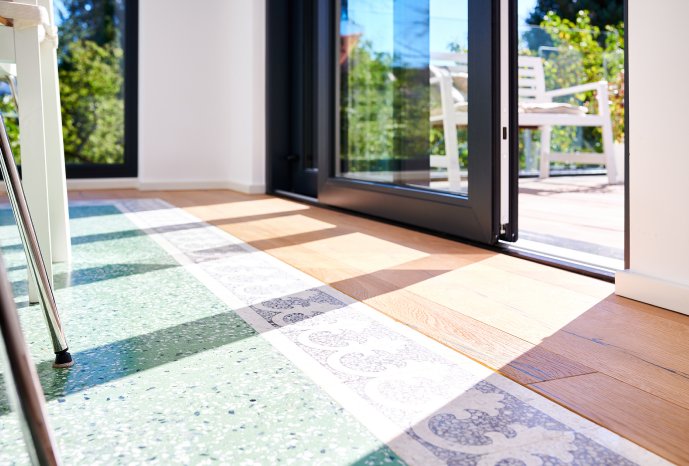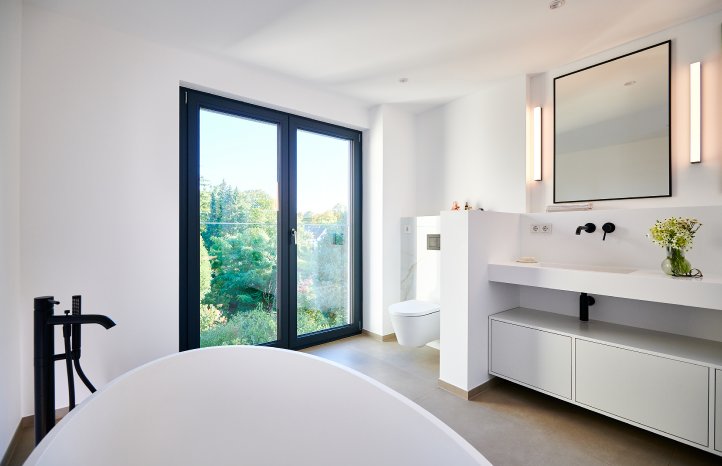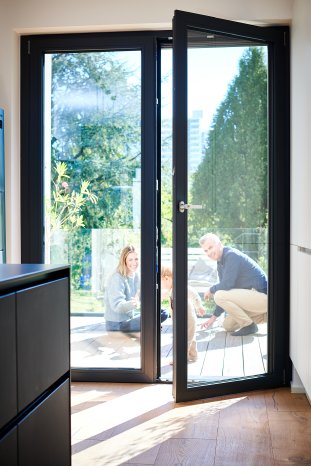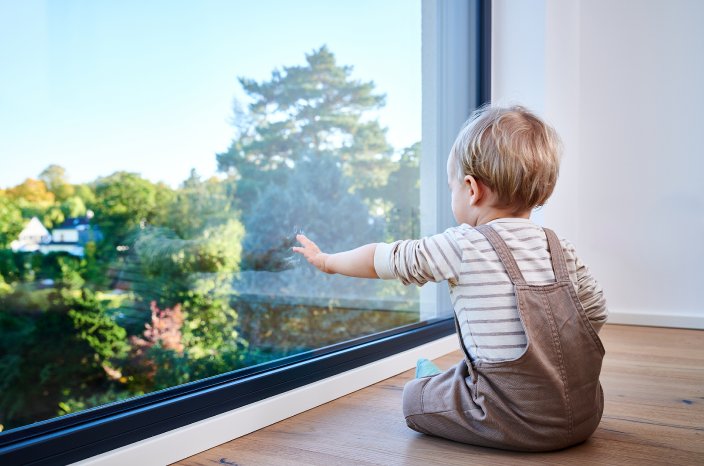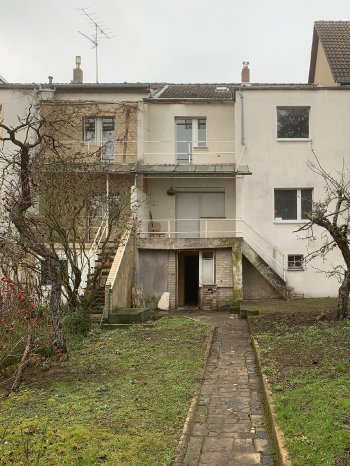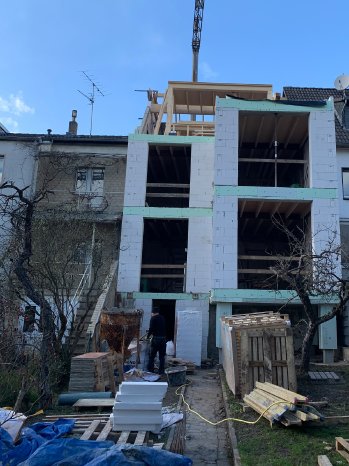Built in the 1920s, largely destroyed during the Second World War and then rebuilt immediately afterwards, the home of the Kuck family from the district of Poll in Cologne has already undergone many changes. It demonstrated its versatility once again in 2021/2022: it was completely refurbished, expanded and adapted to bring it up to today's standards and to meet the individual requirements of the clients.
A house in the heart of Poll, Cologne
The townhouse, which had belonged to Dominic Kuck's grandmother until ten years ago, is located in a large, trapezium-shaped block of houses in the district of Poll on the left bank of the Rhine, close to the city centre. The river is just a few hundred metres away; you can catch a glimpse of it from the front garden. On the southeast side at the rear, the terraced house borders an eight-metre wide and about 50-metre deep garden containing old fruit trees. It is surrounded on all three sides by other private gardens, some of which are very leafy.
"A house in Poll is an absolute gem," says the client, Kerstin Kuck. "It's a dream come true for us. We were able to have a significant amount of involvement in the design of our own home – and start our family here." But getting to this stage did present them with some challenges. Firstly, the grandmother, a child of the war, had accumulated and held on to many possessions throughout her life. It took two years before the house was empty and the young couple were able to get on with the real work.
Taking a cautious approach
One of the things up for debate was whether or not the building should be demolished and rebuilt. However, this would have required the party walls that the house shares with its neighbours to be underpinned – a risk to safety that the married couple were unwilling to take. The remaining option was to renovate the building. "What can we keep of the old building, and what has to go? It was a really emotional time, because at first we didn't know which direction things would go in," the client recalls. They therefore took a slow and cautious approach to the project, exposed the timber ceiling beams and stripped the wallpaper off the walls. For Dominic Kuck, there was no question that he would be getting his own hands dirty. "Anything we can do ourselves," he says, "saves us money. It also makes the house even more our own."
Gutting the existing building
However, the enthusiasm of the first few days soon morphed into a great sense of disillusionment: a lot of the house was dilapidated, not to mention the quality of the materials they found. Hardly surprising, as following the war people used whatever was available at the time: cardboard, rubble and other debris. "Each ceiling had a different filling," says the client. "And the beams were rotten, so we had to completely replace them, unfortunately." At the beginning of 2021, on the advice of their architect Christian Richter from the arctum plus Architekten office in Cologne, the couple therefore decided to completely gut the existing building, although sections of the external wall facing the street were preserved. Another feature that has stood the test of time is the terrazzo flooring in the entrance area, which the clients had extensively repaired by specialists. This material is now a recurring theme throughout the house – there are terrazzo lights above the kitchen island, terrazzo floors and a terrazzo washbasin in the guest toilet, as well as a section of terrazzo flooring embedded in the wooden floor in the dining area.
Using glass to create an open and bright home
The interior of the old building was very dark; there were small windows, confined spaces and an equally narrow staircase. It was very important for the clients to make their new home as open as possible. They had very specific ideas about this: "We wanted the rooms to be as big as possible and flooded with light. That's why glass plays such an important role in our home," explains Kerstin Kuck. "Although we had a limited amount of space, the floor plans had to have a clever design so that each child could have their own room later on."
To create more living space, Christian Richter proposed adding an extra floor as well as a two-storey extension at the rear of the building. As a result, the architect increased the living space from the original 120 square metres to 180 square metres and completely redesigned the garden façade in the process as well. Viewed from the street, only minor changes have been made so that the façade does not stand out from the neighbouring properties. Richter explains: "Although we have retained the small windows on the front façade, we have upgraded them. As the building lives from the inside out, we have created views to match. This has obviously resulted in some different openings than there used to be." PVC-U windows from the Schüco LivIng system have been used throughout. There is one large opening vent and one small fixed unit on the street-facing façade of the townhouse. Their slimline, anthracite grey frames are embedded in a brightly plastered façade with deep reveals.
Living room and kitchen extended out towards the garden
On the garden side of the building, the architect had a different aim for the design: the whole house opens up. Where there used to be balconies, the house has now been extended out by one metre for the kitchen on the ground floor and the bathroom upstairs. Three metres wide and four metres deep, the protruding extension adjacent to it houses sections of the living room and the parents' bedroom. From the living room, you can access a small, steel terrace through a lift-and-slide door from the PVC-U Schüco LivIngSlide system, while the garden can be reached from the terrace via a steel staircase in matching anthracite grey. Access from the kitchen to the balcony is also via a Schüco LivIngSlide Loft door in the same colour, RAL 7016. "To simply open the door, step outside and breathe in the fresh air – it was really important to me to be able to extend the kitchen and living space outside," says the client. "When you set foot inside the house, you look straight into the garden through the kitchen and Loft door. It gives the space enormous depth!" One reason the clients opted for PVC-U windows and sliding doors was the outstanding thermal insulation values combined with the excellent value for money that they offer. However, the design was also pivotal in their choice. Kerstin Kuck: "We wanted the whole frame to have just one colour on the inside, for example. The Schüco series made this possible."
Framing an ever-changing view
In the rear façade, the two floor-to-ceiling fixed openings also create a link with the outdoors: two window units measuring around 2.3 x 2.3 metres from the Schüco LivIng system. They frame a view that changes according to the time of day and the season, creating a different atmosphere inside the home. "It's wonderful waking up to this view of the garden and looking at the greenery and fruit trees from the dining table," the client gushes, before adding: "Schüco products strike a great balance between visual appeal and cost-effectiveness. We're really pleased with them."
Energy consumption significantly reduced
All the windows are triple glazed, which helps to minimise the amount of energy required by the home. Dominic Kuck explains: "Being a terraced house, the heat transmission loss is relatively low as it is enclosed on two sides. It is also fully insulated on both sides, as is the roof. Its primary energy requirement is all that distinguishes it from a KfW 55 home. We barely had the heating on last December. We use gas for heating, but also our fireplace. Only the bathroom has underfloor heating."
The attic is the only floor that has not been completed. That will change when the Kucks' children are older and their rooms are moved there. Sometimes, however, the couple does venture up to the attic. When they do, they enjoy the truly beautiful, light-filled space and the high ceilings, even though it's not yet complete. Through the dormers, which have four large windows on each side, they look out over Cologne's rooftops and the meadows of Poll all the way down to the Rhine. What a wonderful place to live!
Project details
Client: Kerstin and Dominic Kuck, Cologne
Architects: Christian Richter, arctum plus Architekten, Cologne
Windows: JK Hausdesign, Dormagen
Schüco products/materials installed:
Front door: Schüco AD UP 75 aluminium profile, RAL 7016 anthracite grey on both sides
Sliding doors: Schüco LivIngSlide, glossy anthracite grey on both sides, similar to RAL 7016, design: 436-7003A
Windows: Schüco LivIng 82 MD Classic (centre gasket, basic depth of 82 mm), glossy anthracite grey on both sides, similar to RAL 7016, design: 436-7003A
Living space: approx. 180 m2
Completion: December 2022
www.schueco.com
